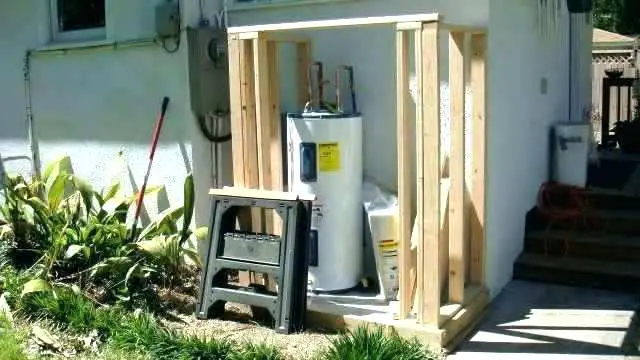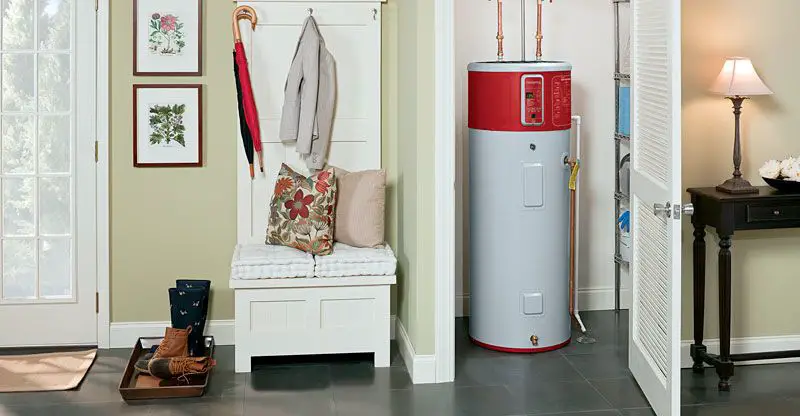Do you have an outside hot water heater? If so, it is important to take precautions to prevent accidental burns. This article will show you how to build a safe and effective outdoor water heater enclosure. One that will protect your family from the dangers of scalding.
What is a water heater enclosure?
A water heater enclosure is a metal cabinet that houses your water heater. It works like the wall framing of the heater. The outside heaters should have enclosures to protect the unit from weathering and rusting. As well as safeguarding it from potential injuries or damage caused by an accident involving children, pets, tools, etc. for curb appeal and adverse weather conditions.
Enclosing your outdoor electric heating system will also provide you with a tidy-looking enclosure. In addition to a safe place to store the water heater electrical cord and gas orifice. Besides, it will also protect your new water heater and give you enough space since you can place the heater outside.
Considerations when building outside water heater enclosure
When choosing a hot water heating enclosure, you should take it into consideration. How often it will be used as well as your climate is you in an area with high precipitation? Will there be snowfall frequently throughout the year? Can the enclosure withstand all these issues? Well, the best enclosures do.
Below are the outdoor water heater enclosure ideas and the common considerations:
- Consider the location you wish to build your enclosure
- Determine if you want a wood, vinyl, or metal construction for your enclosure
- Decide on the size of your outdoor hot water heater and how much space it will occupy in the enclosure
- Call an electrician to install electrical outlets in the area where you plan to place your hot water tank
- Install insulation around pipes that have exposure to the outside elements so they don’t freeze during cold winter months
- Cover any openings in walls with wire mesh or window screens, so bugs can’t get inside during the summer months.
Types of outside water heater enclosures
There are three types of outdoor water heater enclosures:
Frame-built enclosure: This style comes from a wood frame with metal panels on the outside and insulating material inside. A vinyl coating may also be of use to protect against weathering or corrosion.
Metal cabinet enclosure: Outside water heaters can also have an all-metal construction with steel panels, hardware cloth (a type of metal screen), and insulation. Outside electric water heaters can have housing from a strong wooden exterior with mesh walls.
Wall-mounted enclosure: Finally, if you wish to build your own outside hot water heater enclosure. It is possible to construct an all-metal or vinyl cabinet that will mount directly on a wall. You will need to use the appropriate hardware, tools, masonry screws, and similar items.
Different types of outdoor water heaters tank enclosures
Electric tank water heaters enclosures
Outside electric water heaters should have a metal cabinet or galvanized steel. With screened openings for ventilation and insulation space inside. The door of these enclosures can be either have a hinge or slide, depending on its orientation to prevailing winds.
Gas tank water heaters enclosures
When enclosing a gas tank water heater. Be sure to place it in an area that will not allow any fumes from the exhaust or flue pipe to escape. The enclosure should also have adequate ventilation. And make certain there is proper clearance for servicing your hot water heater’s burners.
Outdoor tankless water heater enclosure
There are differences in the designs of tankless gas water heaters, so this type of heater comes with an outdoor enclosure. have a wall mount unit, an outdoor cabinet for indoor installation, and more. Furthermore, they can heat water without a storage tank which means they don’t need an outside enclosure to function properly.
Can you install water heaters outside: What you should know?
There are many different types of water heaters and each one has its own pros and cons. Similarly, the outside heater enclosure is an important thing to consider when making this decision. Because it will be very visible in your backyard or patio area.
Some people use them outdoors, but not all models are for that type of installation. Similarly, you need to think about your space, budget, and personal preferences.
Four water heater enclosure recommendations
- Outside electric hot water heaters should have a metal cabinet or galvanized steel with screened openings for ventilation and insulation space inside. The access door of these enclosures can either have a hinge or slide, depending on its orientation to prevailing winds.
- When enclosing a gas tank water heater, be sure to place it in an area that will not allow any fumes from the exhaust or flue pipe to escape. The enclosure should also have adequate ventilation and make certain there is proper clearance for servicing your hot water heater’s burners.
- Outside tankless water heaters aren’t as common as their storage tank cousins, but they do exist. In fact, it is possible to find both electric and gas models. Outside tankless water heaters have a limited amount of power, so they aren’t effective in larger homes.
- Outside tankless water heater enclosures should have a metal cabinet or galvanized steel with screened openings for ventilation and insulation space inside. The access door should have a hinge, with enough room to maneuver.
FAQs: Common outside water heater :
What is the cost of moving a water heater outside?
The cost to move a water heater is $5,000 on average, and it can be upwards of $80 for hot/cold hoses. Hiring an electrician to install your home’s water heater outside can be expensive. The average cost is $650, but you’ll end up paying even more for labor–which averages out at least $140 per hour!
Is it a good idea to place my water heater in the basement or on the patio?
A lot of people put their house heaters against basement walls, patio or inside garage doors. Make sure you find a position for your water heater near the outer part of your house, so it has enough room to vent outwards with its flue attached on top!
Do water heaters need ventilation?
Yes, outside water heaters should have adequate ventilation, but be careful because too much will cause the unit to overheat.
Can you enclose a hot water tank?
Typically, hot water tanks should not be enclosed, but it is possible to build an outdoor enclosure whenever necessary.
How much space do you need around a hot water heater?
There should be at least two feet of space around the water heater. However, outside electric hot water heaters require additional ventilation for combustion, while gas units rely on a chimney.
How do you hide your hot water heater?
Well, you need an enclosure, and depending on the type of water heater that you have, you can choose from different types of enclosures. Similarly, the outside hot water heater enclosure is the crucial element when it comes to safety and aesthetics, so make sure you choose one that suits your needs.
How do you insulate an outdoor water heater or waterproof the water heater closet?
An outdoor water heater enclosure should have an attachment to the house and insulation. Outside hot water heater enclosures need insulation as well but they also require waterproofing to ensure they maintain their structural integrity.
We have a variety of outdoor water heater enclosures to help protect your family from accidents. Whether you need one for a tankless or traditional hot water heater, we can customize the perfect enclosure for your needs and budget! And at a lower price than our competitors Contact us today if you want more details.
Conclusion
We have a variety of outdoor water heater enclosures to help protect your family from accidents. Whether you need one for a tankless or traditional hot water
Ultimate Guide to the Best indirect water heater #Best Selling Product On Amazon


